State of the fertility sector 2023/24
Annual publication on HFEA licensed clinics
(1st April 2023 – 31st March 2024)
Published: 1st October 2024
Download the underlying dataset as .xlsx
Table of contents
- How we regulate
- 1. Inspections in 2023/24
- 2. There were 226 non-compliances identified at inspection in 2023/24
- 3. In 2023/24, 135 clinics were licensed by the HFEA to provide fertility treatment, storage and/or research
- 4. Total incidents reduced by 8% compared to the previous financial year
- 5. Fewer Ovarian hyperstimulation syndrome (OHSS) incidents were reported in 2023/24
- 6. Patient complaints in 2023/24 were consistent with the previous financial year
- About our data
How we regulate
The Human Fertilisation and Embryology Authority (HFEA) is the independent regulator of fertility treatment and human embryo research in the United Kingdom (UK). We aim to ensure that everyone who steps into a licensed fertility clinic receives high quality care. We regulate fertility clinics and projects involving research with human embryos. This involves licensing, inspections and setting standards. We also provide free, clear and impartial information about fertility treatment, clinics, and egg, sperm, and embryo donation.
Incidents in the UK fertility sector are rare, with over 99% of cycles being carried out without incident. However, when incidents occur we take them very seriously. We ensure incidents are thoroughly investigated by clinics by retaining increased regulatory oversight into their investigation processes and findings until the incident is closed and any lessons learnt have been integrated into practice. If at any point we are not satisfied with the conduct of the investigations, we work closely with the clinic to ensure the process is robust.
This year there has been a high level of media interest in incidents within the sector and how they have been responded to by clinics and the HFEA. The reported incidents and regulatory action taken this year have demonstrated how regulatory oversight can identify concerns and lead to improvements for patients and for clinic staff.
To maintain robust regulatory oversight, we inspect licensed premises at least every two years as required by the law. Where we have concerns, inspections will be more frequent and a clinic would be monitored closely through enhanced regulatory oversight such as more frequent contact, onsite visits or unannounced inspections. All inspection reports go before a separate licensing panel to consider their recommendations before making a final decision. When inspection reports and their recommendations are particularly complex or very serious incidents occur, these are referred to the HFEA’s Licence Committee (LC), comprised of Board members and with a lay chair. The LC meets regularly, always with a legal advisor present. All of this information is published on our website.
The ‘State of the fertility sector’ report summarises what we have seen through our regulatory work during the year. The report is published annually and is compiled from information gathered from our inspections and from other sources of information including our Register of fertility treatments, incident reports, and patient feedback mechanisms. We also publish Quarterly Clinical Governance Updates (shared via our Clinic Focus newsletter), which provide clinics with detailed insight into non-compliances in a timely manner to help them improve compliance and prepare for inspections. These updates also contain details of incidents and complaints to ensure clinics can implement any recommendations to help prevent further recurrence.
We collect patient feedback via the Choose a Fertility Clinic page on our website where patients can comment on their own experiences. This feedback is reviewed by inspectors and where any concerns are raised, this is then taken up with the clinic. Patient feedback is very helpful to inspectors, and clinics are encouraged to ask patients to visit the HFEA website to provide it.
1. Inspections in 2023/24
Clinics are assessed using a hybrid approach involving a desk-based assessment combined with an onsite visit. This approach is robust and efficient, allowing the inspection to focus on specific areas of concern and areas which are better assessed on site. HFEA inspectors have expert knowledge relating directly to the sector and include both clinical and scientific inspectors that focus on specific areas at inspections. Each inspector oversees a portfolio of clinics which enables regulatory knowledge to be built up around each one, and for working relationships to be built between the clinic and inspector.
In 2023/24, 104 inspections were carried out, which is an increase from 85 in 2022/23 (Figure 1). This increase is largely because of a change to licence length which occurred during the COVID-19 pandemic resulting in more clinics being due for a renewal inspection in 2023/24.
Five additional inspectionsI were conducted in 2023/24 where significant concerns had been identified, for example after incidents were reported, complaints were raised or where whistleblowing occurred. In cases such as these, additional onsite visits are necessary to ensure regulatory oversight and scrutiny is maintained and to provide reassurance that corrective actions are being implemented.
Following each inspection, a report identifying areas of good practice and those which were non-compliant and require improvement is presented to a separate licencing committee to review and make a final decision. The report is then published on the HFEA website via the respective clinic’s Choose a Fertility Clinic webpage. The recommendations from HFEA inspectors enable clinics to make improvements to reach the standards expected of them within an agreed timeframe. Further regulatory oversight or action can be taken if these improvements are not made.
Figure 1. There were 104 inspections undertaken in 2023/24
Number of inspections by type, 2019/20-2023/24
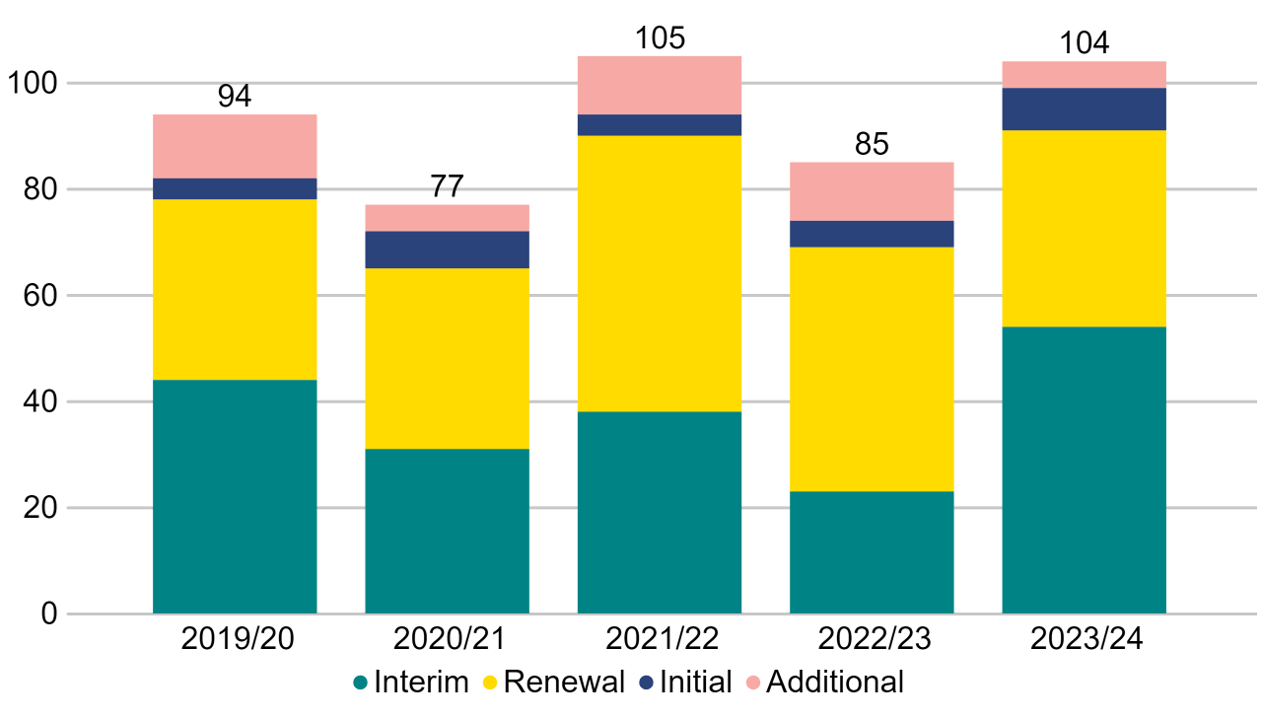
Note figure 1: Interim inspectionsI include three focused interims. Renewals include two inspections for the same clinic, as an extra inspection was needed to gain more information. Additional inspections include four change of premises inspections and one variation of premises inspection.
Download the underlying data for Figure 1 as Excel Worksheet
2. There were 226 non-compliances identified at inspection in 2023/24
During inspections, areas of non-compliance are identified in reference to the relevant sections of the Human Fertilisation and Embryology (HFE) Act 1990 (as amended), Standard Licence Conditions, General Directions, or the Code of Practice. These non-compliances are classified as ‘critical’, ‘major’ or ‘other’II. Clinics are required to implement these actions to correct these findings within specified timescales and progress is monitored by the HFEA Inspection team. If a clinic fails to resolve non-compliances, we may take regulatory action. Further information about how the HFEA handles non-compliance can be found in the HFEA Compliance and Enforcement policy.
Figure 2. There were 226 non-compliances identified at inspection in 2023/24
Number of non-compliances by grade, 2019/20-2023/24
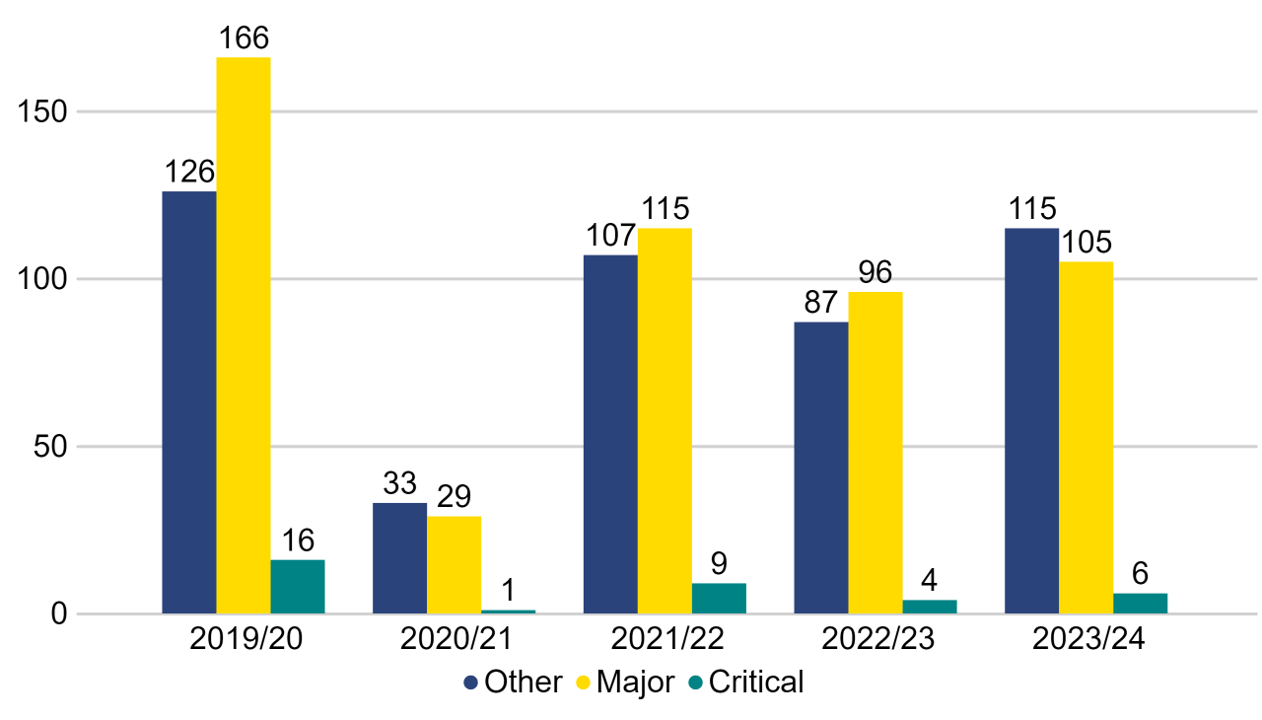
Note figure 2: Treatments in 2020/2021 were impacted by COVID-19 measures introduced by the HFEA. For more information on these, see State of the fertility sector 2020/21. Non-compliance figures do not include research-only clinics.
Download the underlying data for Figure 2 as Excel Worksheet
3. In 2023/24, 135 clinics were licensed by the HFEA to provide fertility treatment, storage and/or research
There were 135 HFEA licensed clinics active in 2023/24, a similar number to recent years. While the overall number of clinics has remained consistent for many years, the licence type makeup of the clinics has changed a little. In 2023/24, five more of these clinics were offering treatment with storage, and fewer clinics were offering treatment only, or storage only, when compared to 2019/20 (Figure 3).
In 2023/24, there were 107 fertility clinics licensed by the HFEA to provide fertility treatment in the UK. An additional 17 establishments were licensed to undertake research only and 11 were licensed to provide storage only.
The largest number of treatment clinics was in London (35 clinics; Figure 4), followed by the North West, South East (ten clinics each) and West Midlands (nine clinics). Northern Ireland had the fewest treatment clinics at three.
Figure 3. Most HFEA licensed clinics provided both treatment and storage to their patients
Number of licensed clinics by licence type, 2019/20 and 2023/24

Download the underlying data for Figure 3 as Excel Worksheet
Figure 4. London had the highest number of HFEA fertility clinics licensed for treatment at 35
Number of fertility clinics licensed for treatment by geographical area, 2023/24
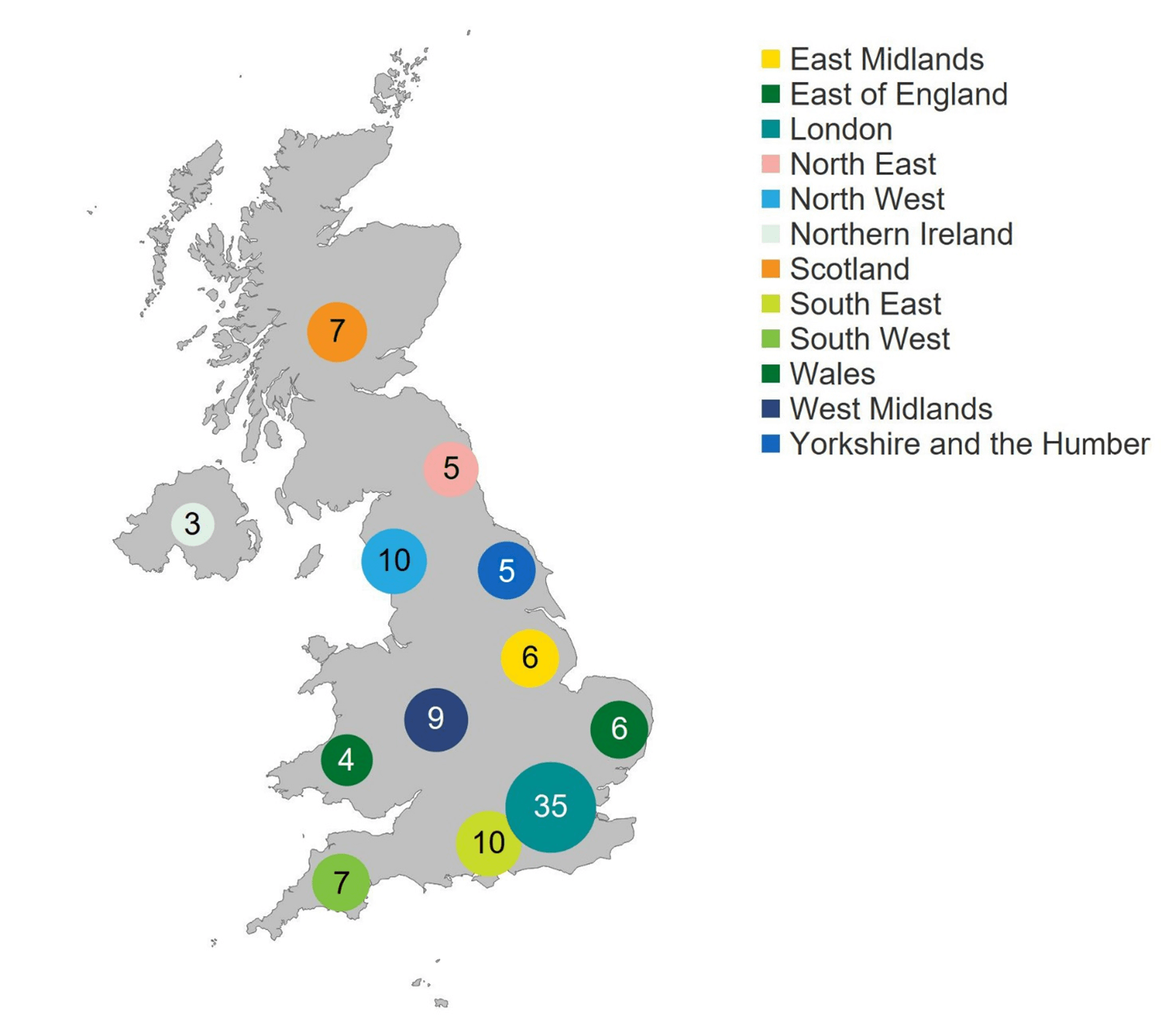
Note figure 4: This figure shows only clinics licensed by the HFEA to perform fertility treatments, meaning that storage only or research clinics are not included.
Download the underlying data for Figure 4 as Excel Worksheet
4. Total incidents reduced by 8% compared to the previous financial year
Almost 100,000 treatment and storage cycles are carried out each yearIII, and over 99% of these are carried out without any incidents being reported. When incidents do occur, the HFEA assigns a grade based on the harm, or potential for harm to have been caused, and to how many patients or their gametes or embryosIV. Clinics and the HFEA take adverse incidents very seriously, and we have a rigorous process for reporting, processing, and investigating adverse incidents and near misses (see the Code of Practice and Standard licence conditions for more information).
Reporting adverse incidents is a statutory requirement, and is recognised as one of the best ways of ensuring that incidents and their causes are identified. This process allows clinics across the sector to learn from incidents and ensure changes can be made to prevent reoccurrence. We monitor incidents in clinics to make sure that everything is done to understand what went wrong and, crucially, to take steps to ensure it does not happen again. We also share learning and notify other clinics of potential issues to ensure the sector learns from these. The Quarterly Clinical Governance Updates provide clinics with detailed insights into incidents.
There were 581 incidents reported to the HFEA in 2023/24, 52 fewer than in 2022/23 (Figure 5):
- There was one Grade A incident in 2023/24, which is the first Grade A incident reported since 2019/20 when there were two.
- There were 202 Grade B incidents in 2023/24, 24 fewer than the previous financial year. The total number of Grade B incidents also includes 53 severe/critical OHSS incidents.
- Grade C incidents remained consistent with the previous financial year with 289 incidents in 2023/24, compared with 291 in 2022/23.
- Near miss incidents decreased to 62 in 2023/24 from 89 in 2022/23, and 121 in 2021/22.
- 27 incidents were yet to be assigned a grade or confirmed to be incidents (TBA) at the data cut-off date for this report.
A table showing a breakdown of incidents by grade and classification for each clinic can be found in the underlying data for this report.
In May 2023, the Homerton Fertility Clinic reported a Grade B incident, which was followed by two further incidents reported in October and December 2023. The October and December incidents were not graded in this reporting year as the HFEA was awaiting submission of further information required as part of the incident investigation. However, in March 2024 the HFEA's Licence Committee (LC) made the decision to suspend this clinic's licence due to the potential risks to the safety of patients, gametes and embryos following the three reported incidents (Licence Committee minutes – 12 March 2024). A decision to suspend a licence is not taken lightly and is a rare event in a widely safe sector. Following the end of the financial year that covers this report, and after working closely with the clinic and receiving a report from the clinical governance team at the HFEA, the LC was satisfied that the clinic has put measures in place to mitigate risks and provide safe and effective care to patients. Therefore, as of 8 August 2024 the suspension has been lifted (Licence Committee minutes – 7 August 2024). These two previously ungraded incidents have now been retrospectively graded as a Grade A, and a Grade B incident.
Field Safety Notices / Alerts
Field Safety Notices (FSNs) are important communications from the manufacturer about the safety of a medical device. These are sent to the Medicines and Healthcare products Regulatory Agency (MHRA) in the first instance, who notify us in turn via the Government website. The HFEA issues alerts about FSNs that affect the fertility sector. FSNs contain information about what clinics need to do to reduce the specified risks of using the affected medical device(s) and set out any corrective action that they need to undertake. We voluntarily notify licensed clinics of relevant FSNs to ensure they are acted upon appropriately. Clinics should have a process in place for acting on FSNs and alerts as well subscribe to the government website to ensure they receive all necessary FSNs. There is also a legal duty for clinics to report any incident to the HFEA. There were 16 FSNs issued by the MHRA and passed on to clinics by the HFEA in 2023/24.
Figure 5. 581 incidents were reported to the HFEA in 2023/24
Number of incidents reported to the HFEA, 2023/24
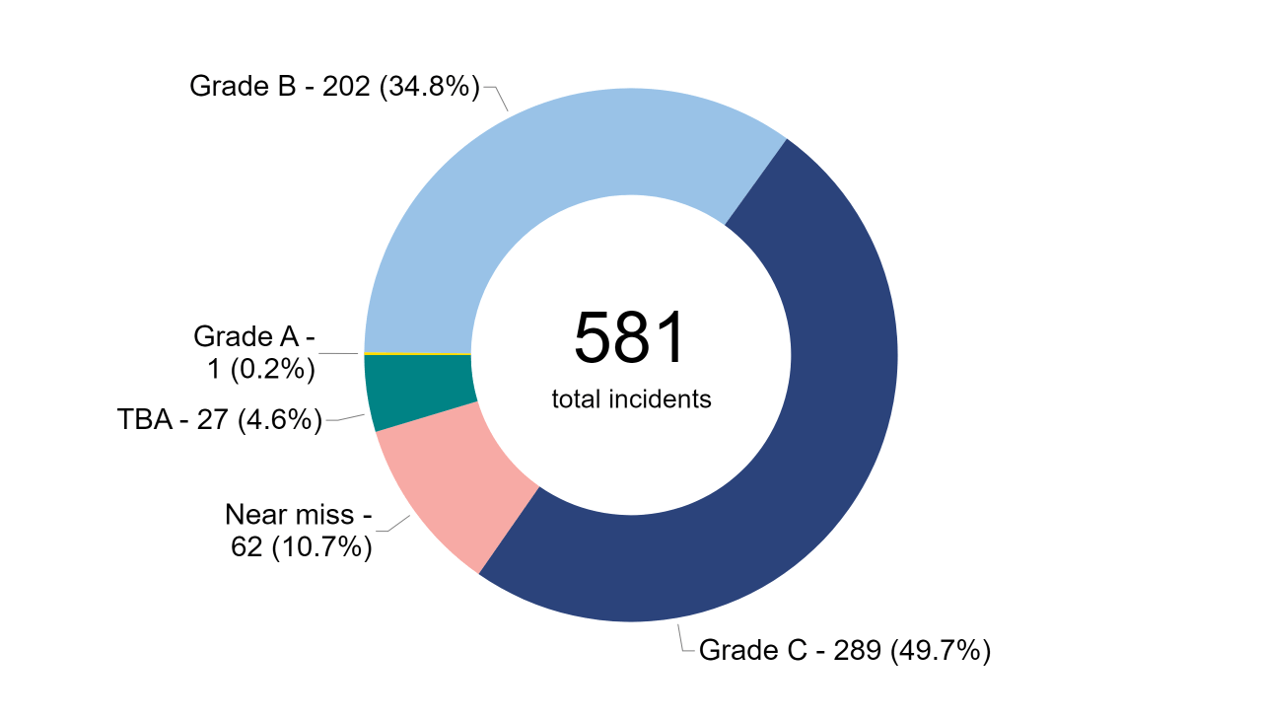
Note figure 5: The 202 Grade B incidents include 53 severe and/or critical OHSS incidents. In previous editions of State of the fertility sector, the total incidents figure included only Grade A, B and C incidents. This total includes Grade A, B and C incidents, as well as Near miss and TBA incidents. TBA incidents are those which were yet to be assigned a grade, or officially confirmed to be an incident, at the data cut-off date of this report.
Download the underlying data for Figure 5 as Excel Worksheet
5. Fewer severe/critical OHSS incidents were reported in 2023/24
Ovarian hyperstimulation syndrome (OHSS) is a potentially serious side effect of fertility drugs taken to increase egg production. OHSS can range in severity from mild to critical, and is graded by the patient’s clinic in accordance with guidelines by the Royal College of Obstetricians and Gynaecologists (RCOG). Because of the potentially serious nature of OHSS, all cases of severe or critical OHSS must be reported to the HFEA within 24 working hours by the patient’s clinic and are categorised by us as Grade B incidents.
In 2023/24, there were 53 cases of severe and critical OHSS reported by UK clinics, occurring in less than 0.1% of cycles (Figure 6).
Figure 6. Severe and critical OHSS incidents decreased in 2023/24
Number of severe and critical OHSS incidents reported, 2019/20-2023/24
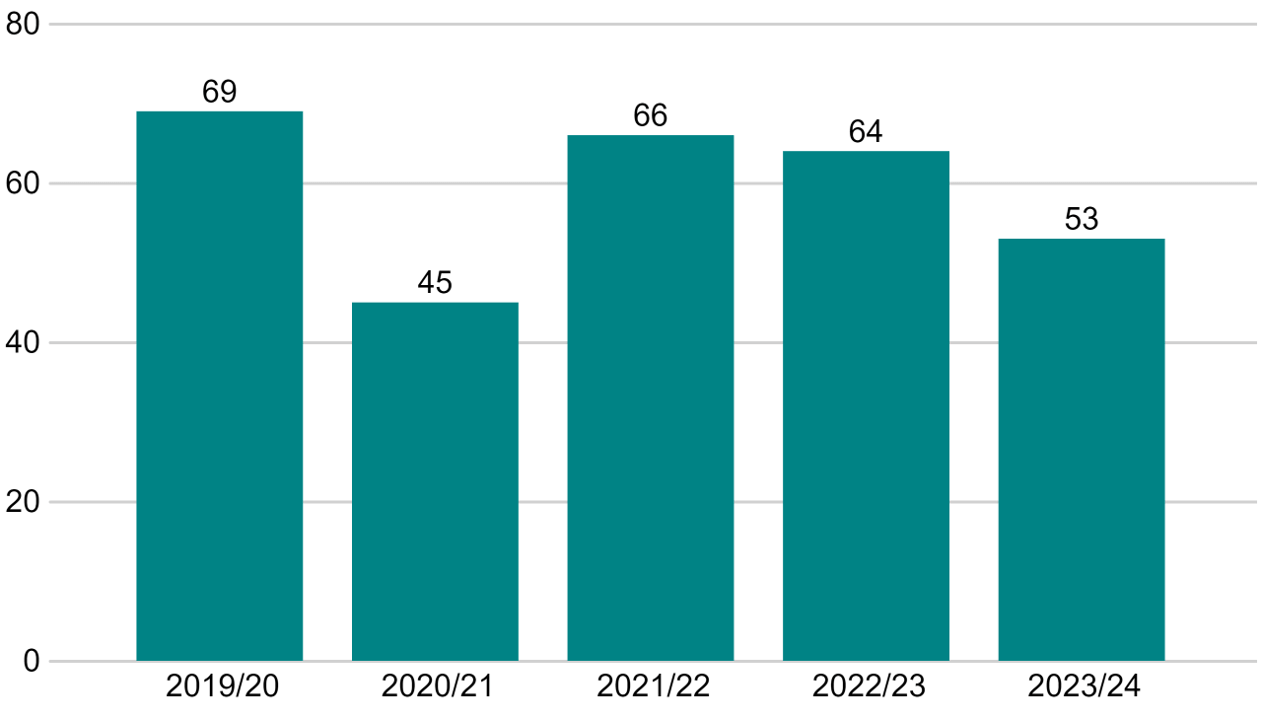
Note figure 6: Treatments in 2020/2021 were impacted by COVID-19 measures introduced by the HFEA. For more information on these, see State of the fertility sector 2020/21. This data includes severe and/or critical OHSS cases only. These severe and critical OHSS incidents are also included in the Grade B incident totals provided in Figure 5. Mild and moderate OHSS cases are not included in this data as these are not classed as incidents.
Download the underlying data for Figure 6 as Excel Worksheet
6. Patient complaints in 2023/24 were consistent with the previous financial year
Anyone using services within HFEA licensed clinics can raise a complaint with us if they are unsatisfied with how a clinic has handled their original complaint. However, unlike some other regulatory bodies, the HFEA does not have a statutory duty to investigate patient complaints. We can only consider a complaint when it indicates a potential breach of the HFE Act 1990 (as amended), licence conditions, or the guidance set out in the Code of Practice. This means we may not be able to review specific medical decisions made during a patient’s care pathway, nor can we intervene to require a clinic to provide a refund or financial compensation. The number of patient complaints handled by the HFEA is therefore not a reliable indicator of the levels of patient satisfaction. The HFEA carries out a National Patient Survey every three years to collect an overall level of patient satisfaction with UK fertility treatment.
Complaints received are often multifaceted and the complexity of patient complaints continues to increase. We publish the Quarterly Clinical Governance Updates to provide clinics with detailed insight into complaints.
The way we handled complaints changed in 2022/23, leading to fewer complaints being classed as ‘formal’ from then onwards. We now encourage patients to first attempt to resolve the complaint through direct communication with the clinic, before officially raising it with the HFEA.
There were 69 patient complaints received in 2023/24, which is an increase of ten since the previous financial year (Figure 7). This includes 14 formal complaints and 55 informal complaintsV.
In 2023/24, similarly to the previous financial year, many of the complaints we received related to poor communication and decisions made during the patient’s care pathway. We also received several patient complaints about the lack of engagement once a formal complaint was made with their clinic. We strongly urge clinics to review their complaint policies to ensure complaints are acknowledged and responded to within their policy timeframes. If a complaint response is going to be delayed, clinics should explain the reason for the delay and offer an apology as well as providing a revised timeframe for the response.
We actively monitor and review the information we receive from patient complaints and feed this into the inspection process. We discuss formal complaints with the clinic and encourage them to further engage with the complainant to try to resolve the issues raised locally. Complaints are discussed at regular HFEA internal clinical governance meetings to ensure clinics are actively engaging with patient complaints and providing thorough and well considered responses. We expect clinics to provide a sincere acknowledgement of the complainant’s experience; to explain what, if anything, went wrong; what measures the clinic has put in place to minimise the risk of this happening again, and what the clinic can offer the complainant by way of support.
Figure 7. Patient complaints in 2023/24 were consistent with the previous financial year
Number of informal and formal complaints received, 2019/20-2023/24
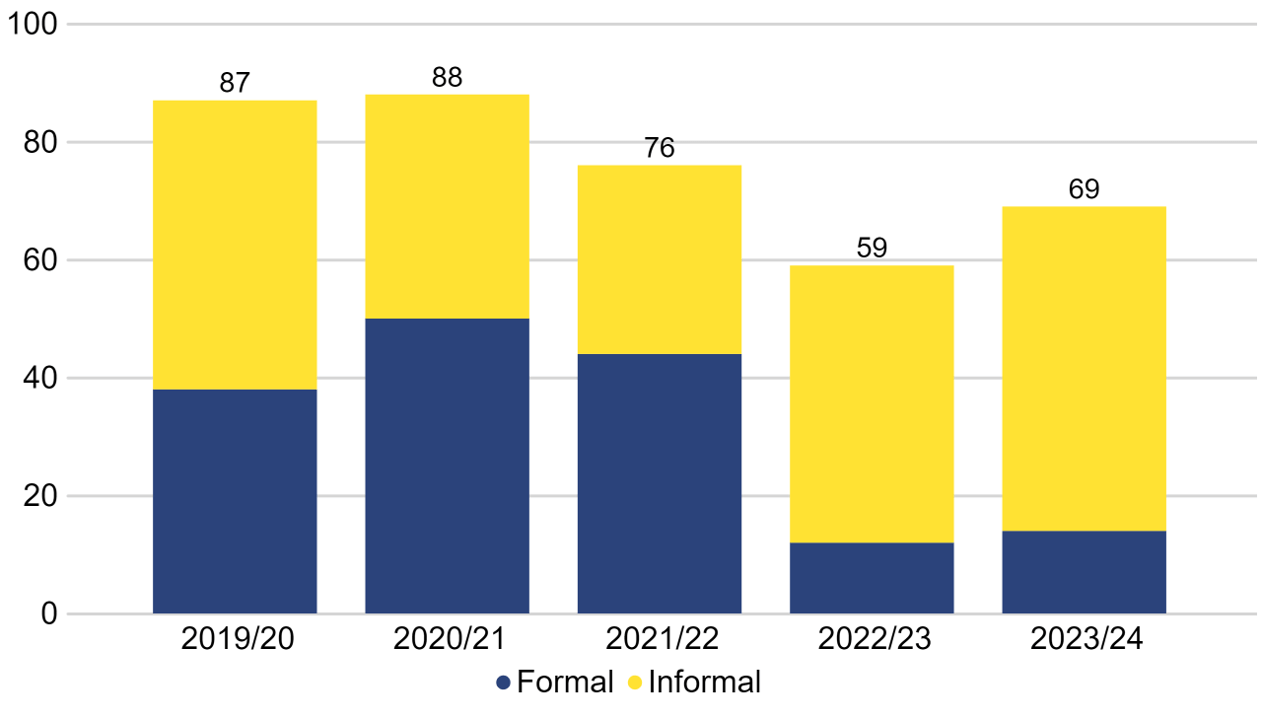
Note figure 7: From 2022/23 the HFEA changed how it handles complaints, leading to fewer being classified as formal complaints. See Section 6 for more information on the complaints process.
Download the underlying data for Figure 7 as Excel Worksheet
About our data
This report is compiled from information gathered from our inspections throughout the year and other sources of information, including incident reports, patient feedback, and patient complaints.
This report also uses preliminary treatment data for 2022 from the HFEA Register of fertility treatments. The HFEA has recently launched a new data submission system for licensed clinics and has migrated its fertility treatment and outcomes data to a new database. This data migration has resulted in delays that have prevented the validation of the 2020-2022 treatment and pregnancy data and 2019-2022 birth outcome data. Data validation involves data quality checks that verify treatment, pregnancy and birth outcome data.
The information that we publish is a snapshot of data provided to us by licensed clinics. The figures supplied in this report are from our data warehouse containing Register data as of 16 May 2024. Results are published according to the year in which the cycle was started.
A full list of definitions of classifications of incidents and complaints are available in the underlying dataset.
Contact us regarding this publication
Media: press.office@hfea.gov.uk
Statistical: intelligenceteam@hfea.gov.uk
Accessibility: comms@hfea.gov.uk
For general information about the HFEA, fertility treatments, and research activity, please visit the HFEA website. For guidance on how to make a complaint about a clinic, please visit our Problems at your fertility clinic webpage.
Notes on State of the Sector 2023/24
- Inspections are carried out by the HFEA to assess whether clinics comply with essential requirements in providing safe and high-quality care to patients and donors. Inspections are categorised as follows:
- Initial: The first inspection in relation to a new clinic licence application, which covers all areas of regulatory compliance. New licensed clinics usually receive a licence to operate for up to two years for an initial licence, however established clinics and new clinics that are part of a fertility clinic group generally receive a licence for up to four years. (five years is the maximum length of a treatment licence permitted by law).
- Interim: An inspection that assesses set themes, as well as any non-compliances identified in previous inspections. Interim inspections include a shorter site visit, are unannounced and are usually carried out at the midpoint of the existing licence.
- Focused interim: An interim inspection focused on particular areas of regulatory compliance. These can be carried out for many reasons, including as a response to a serious incident; to concerns identified in a previous inspection; to a whistleblowing event; or by request of the HFEA licence committee.
- Renewal: An inspection that includes a thorough assessment of all aspects of regulatory compliance, as well as any non-compliances identified in previous inspections. As clinics are usually granted a four-year licence, the renewal inspection is carried out every four years.
- Additional: These inspections are usually focused on a particular area of regulatory compliance, and may be carried out in a number of circumstances including by request of the HFEA licence committee, in the event of a variation of premises, in response to a serious incident and/or whistleblowing, or in the event of any other concerns identified.
- Non-compliances are graded as:
- Critical: An area of practice that poses a significant risk of causing harm to a patient, donor, embryo or to a child who may be born as a result of treatment services; or a significant shortcoming from the statutory requirements.
- Major: An area of practice that poses an indirect risk to the safety of a patient, donor, embryo or to a child born as a result of treatment services. This area of non-compliance may also indicate a major shortcoming from the statutory requirements and/or indicate a failure by the Person Responsible to carry out their legal duties.
- Other: An ‘other’ area of practice that requires improvement is any area of practice, which cannot be classified as either a critical or major area of non-compliance, but which indicates a departure from statutory requirements or good practice.
- In 2022 there were approximately 97,000 cycles of treatment and storage involving approximately 61,700 patients:
- Approximately 82,824 treatment cycles (around 77,000 IVF; 5,700 DI)
- Approximately 13,900 storage cycles (around 4,600 egg storage cycles; 9,300 embryo storage cycles)
- Incidents are graded as:
- Grade A: involves severe harm to one person, or major harm to many
- Grade B: involves serious harm to one person, or moderate harm to many
- Grade C: involves minor harm
- Near miss: an event not causing harm, but with the potential to cause injury or ill health.
- Complaints are classified as:
- Formal: where the patient/donor has received a response from the clinic but remains dissatisfied, and/or where the clinic has entered an extensive dialogue with the complainant and at the end of this process feel they have done all they can to resolve the complaint, therefore advising the complainant to contact us. Complaints relating to an incident or complaints that relate to complex issues requiring further input from us are also classified as formal complaints.
- Informal: complaints that have not been raised with the clinic or complaints still going through the clinic’s complaint process.
Review date: 15 April 2027

